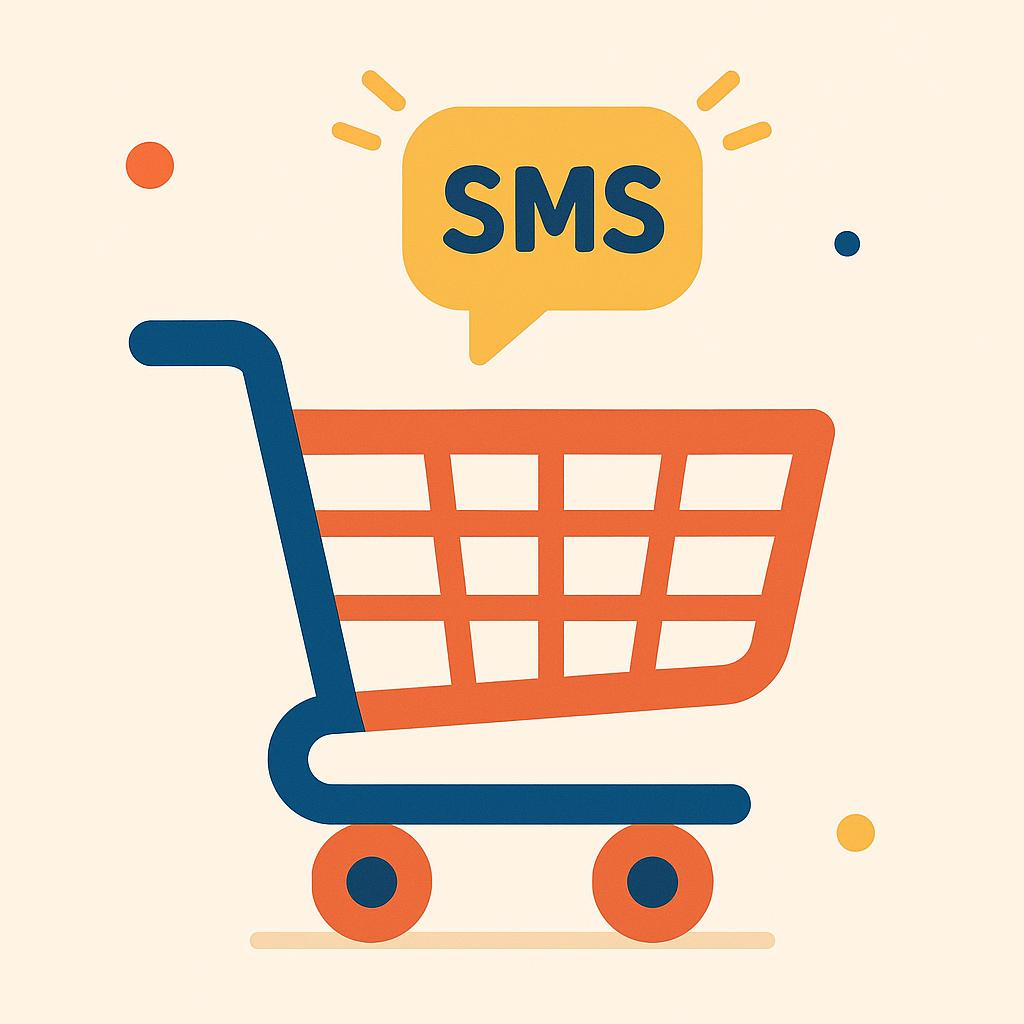Ecommerce SMS marketing is the quiet workhorse of direct-to-consumer growth.
It delivers short messages that help shoppers take the next step, then measures results without speculation.
It pairs speed with consent. It also fits cleanly into storefronts and checkout flows, which makes it easy to trigger the right text at the right moment.
This article shares best practices, examples, tools and actionable tips for success.
What Is Ecommerce SMS Marketing
Ecommerce SMS marketing means sending text messages to customers with updates, deals, and notifications. This helps shoppers make purchases, receive their orders, and return to buy again.
Businesses gather customer opt-ins, segment their audience based on behavior, and deliver relevant messages.
The best programs mix transactional notifications with promotional campaigns. Transactional texts earn trust and keep buyers informed. Promotional texts drive conversion and retention.
How SMS Marketing Fits Into Ecommerce
Text messaging sits beside email, paid social, and on-site experiences. It adds immediacy and a direct path back to the store.
- In checkout, customers may opt in for order alerts. That consent can include marketing.
- In post-purchase flows, delivery and review requests keep the conversation going.
- In omnichannel marketing, SMS complements email and ads with short reminders.
Why SMS Outperforms Other Channels
SMS often gets seen within minutes. Messages land in the default texting app, so there is little friction.
- Attention is high. A short message with a single link is hard to miss.
- List quality is strong. People who opt in are usually closer to purchase.
- Deliverability is stable when consent and data hygiene are handled well.
Email remains vital, yet inbox competition is intense. If a brand struggles with low inbox placement or slow reaction time, learning about the problem with email marketing today provides context for when to shift effort to SMS.
Key Use Cases for Ecommerce SMS Marketing
Programs grow fastest when they focus on specific jobs to be done. These are the common ones that pay off quickly.
Transactional Messages and Order Updates
Customers expect shipping alerts. Clear texts reduce support tickets and anxiety.
Send:
- Order confirmation with a link to view the order
- Shipping notice with carrier tracking
- Out-for-delivery and delivered confirmations
- Return received and refund issued
Shopify guide to SMS marketing helps with setup details and triggers.
Abandoned Cart and Re-Engagement Campaigns
Cart recovery texts remind shoppers within 30 to 90 minutes. A friendly tone and a short link keep friction low.
- First nudge: “Saved your items. Want to finish checkout?”
- Second nudge: Include free shipping or a small incentive.
- Win-back: Target lapsed buyers with a relevant new arrival.
Case snapshot: A small beauty shop sent a two-text cart sequence. Text 1 at 45 minutes, Text 2 at 20 hours with free shipping. Click rate averaged 18 percent across both messages, and the flow drove 9 percent of weekly revenue. Results will differ by category and margins, but the pattern often repeats.
Promotions, Flash Sales, and Loyalty Programs
SMS shines when urgency is real. Send short, precise offers.
- Launches with early access windows
- “Back in stock” pings for waitlist customers
- Loyalty balance updates or birthday rewards
- Local events or pop-up reminders
Keep discounts tight. Send to engaged segments first to protect margin and sender reputation.
Building a Compliant SMS Subscriber List
Consent is the foundation. Start there, then make it simple to join and leave.
Collecting Opt-Ins the Right Way
Use clear language and make value obvious.
- Add opt-in at checkout with exact terms and a link to privacy details.
- Use popups with an incentive, then confirm with double opt-in.
- Capture keywords, like “JOIN,” on site banners or packaging inserts.
- Offer SMS in social bios and post-purchase pages.
- Always include “Reply STOP to opt out” in promotional messages.
Quality beats quantity. Lists grow slower when rules are followed, but they convert better.
Meeting Legal and Privacy Requirements
Rules vary by region. Teams should consult counsel for specific applications, yet these resources outline core principles:
- United States: The FCC guidance on the Telephone Consumer Protection Act explains consent requirements and quiet hours for certain call types.
- European Union: The EU Commission overview of GDPR details lawful bases for processing and data rights.
Document consent, sync preferences across tools, and store proof of opt-in. This protects customers and the brand.
Tips for Crafting High-Performing Ecommerce SMS Campaigns
High-performing programs keep copy short, timing sensible, and offers clear.
A few small habits change results in a big way.
1. Writing Clear, Actionable Messages
Texts that win are straightforward and human.
- Lead with the value in the first line.
- Add one link and a single next step.
- Include brand name and opt-out language.
Examples:
- “Acme: Your order shipped. Track it here: acme.co/track”
- “Acme: Last sizes of the Weekender are back. Grab yours: acme.co/weekender”
- “Acme: 20% off ends at midnight. Use code NIGHT20: acme.co/checkout”
Limit exclamation overload, avoid jargon, and keep brand voice consistent with site and email.
2. Personalization and Timing
Personalization helps when it is specific and respectful.
- Use first name, recent purchase, or category interest.
- Segment by last activity and spend tier.
- Send during local daytime hours, typically 9 a.m. to 8 p.m.
Start with engaged segments, then widen reach. Treat timing like an experiment, not a fixed rule. This is similar to what social teams explore when reviewing best practices for posting time.
Mind SMS deliverability. Throttle sends for very large lists, prune inactive subscribers, and avoid surprise high-frequency days.
3. Testing and Refining Message Strategy
A simple testing rhythm catches quick wins.
- Pick one variable per send. Try call-to-action phrasing, offer framing, or link placement.
- Run A/B tests on send time by zone. Compare late morning against early evening.
- Review metrics weekly. Track click rate, conversion, revenue per message, and unsubscribe rate.
Every quarter, analyze attribution overlap with email and ads. This clarifies where SMS helps most in your omnichannel marketing plan. If click-throughs are weak, revisit the CTA.
Best Ecommerce SMS Marketing Tools
Teams tend to choose platforms that integrate with their storefront, ESP, and ad platforms. The picks below are common in retail and DTC. Pricing and features change often, so verify details during trials.
| Tool | Notable features | Pricing style | Best for |
|---|---|---|---|
| Attentive | Compliance flows, two-way replies, popups | Tiered by volume and features | Mid-market to enterprise |
| Klaviyo | Unified email + SMS flows, segments, UTM tracking | Add-on to email pricing, volume based | Stores already on Klaviyo |
| Postscript | Keyword growth tools, Shopify deep links, support for replies | Volume based with plan tiers | Shopify-first teams |
| Yotpo | SMSBump heritage, loyalty integration, onsite capture | Tiered, volume based | Brands using Yotpo suite |
| Omnisend | Automation templates, cross-channel campaigns | Tiered with free starter | Small to mid-size shops |
Shortlist two or three, run short trials, and compare reporting, ease of use, and compliance guardrails before committing.
If you want everything in one place, Stryng is an AI-powered all-in-one content marketing platform ideal for ecommerce. It automates content creation, visuals, scheduling, publishing, and SEO, keeping every channel consistent and optimized. You can try Stryng for free, or contact the Stryng team to manage your content and marketing for you.
Mistakes in Ecommerce SMS Marketing
Mistakes happen when pressure to hit numbers overrides customer care. These are the frequent culprits and the fixes that prevent them.
Over-Messaging and Poor Timing
Sending too many texts reduces trust and drives opt-outs.
- Cap weekly promotional sends. Many brands stay near 1 to 3, then increase during events.
- Respect quiet hours by local time. Schedule ahead for holidays.
- Segment by engagement. Reduce frequency for low engagers.
Watch unsubscribe rate after each send. If opt-outs spike, review timing, offer, and segment at once.
Compliance Oversights and Data Mismanagement
Small misses in setup can snowball into risk.
- Missing or vague consent language on popups and checkout.
- No double opt-in for high-risk incentives.
- Opt-outs not synced across platforms, leading to unwanted sends.
- Poor data retention policies and weak access controls.
Add periodic audits. Verify opt-out flow, privacy policy links, and role-based access for staff.
Summary
- Ecommerce SMS marketing reaches customers fast and drives action with clear calls to action.
- The channel works best when consent, timing, and personalization are handled with care.
- Key use cases include transactional updates, cart recovery, promotions, and loyalty.
- Compliance is important. Respect opt-ins, quiet hours, and local rules.
- Short copy wins. One goal, one link, one CTA.
- Testing is ongoing. Iterate on timing, audience, and creative to improve outcomes.
- Choose tools that match your stack, budget, and reporting needs.
Frequently Asked Questions
Q: How often should an ecommerce brand send promotional texts?
A: Many teams start with one to two per week, plus transactional updates. Increase frequency during peak seasons, but watch unsubscribe rate and conversion.
Q: What is the difference between SMS and MMS for online stores?
A: SMS carries plain text. MMS supports images and longer characters. MMS can drive attention for launches or seasonal offers, but it costs more per send.
Q: How does shopify SMS marketing fit into existing flows?
A: It typically plugs into checkout, order status pages, and automation tools. Consent is gathered at checkout or via popups, then flows handle order alerts and cart recovery.
Q: Which metrics matter most for SMS?
A: Click rate, conversion rate, revenue per message, unsubscribe rate, and list growth. Over time, compare revenue share from SMS to other channels to see real impact.
Q: What helps improve sms deliverability quickly?
A: Remove inactive numbers every quarter, keep messages short, and avoid sending too many texts in a short window. Good consent practices protect sender reputation.
Q: What is the best time to send a text campaign?
A: Late morning or early evening in the customer’s local time often works. Test this for each segment and season, then set time windows accordingly.



